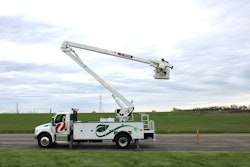
Hexagon Composites has teamed up with Austria-based Cryoshelter to help market a unique tank that offers a leap ahead to gaseous fuel liquefaction which extends vehicle range and cuts down on trips to the pump versus conventional gaseous fuels.
Simply put, converting gaseous fuels like renewable natural gas and hydrogen into a liquid state allows for increased fuel capacity within a tank which equates to more time on the road. But enabling a truck to run on liquified gas is a tall order, and Hexagon believes Cryoshelter is up to the task.
“Cryoshelter has a potentially disruptive technology with competitive edge compared to existing technology alternatives in the market,” said Jon Erik Engeset, CEO of Hexagon Composites which announced a 40% stake in Cryoshelter in April.
Gas liquefaction has been used for mass fuel transport on tanker trucks where pipelines aren’t available according to the U.S. Department of Energy. Equipping trucks with Cryoshelter tanks to run on liquified renewable natural gas or liquified hydrogen is a cutting-edge approach which Hexagon wants to take from testing to market where fleets are increasingly looking for the cleanest fuels that offer the longest ranges.
“Our goal is to aid the commercialization and industrialization of this technology,” Engeset added.
Fleets may come calling since liquified hydrogen can provide up to 40% additional range over compressed hydrogen.
“With compressed hydrogen, fleets may be able to achieve 800 miles of range,” said Todd Sloan, executive vice president of Hexagon Purus, a division of Hexagon Composites which focuses on hydrogen storage.
“With the Cryoshelter technology providing liquid storage we will be able to get up to 180kg of hydrogen storage so that fleets can extend range to approximately 1200 miles, so that is a big advantage,” Sloan continued. “The entire vehicle is a bit heavier than diesel but not by much, and the higher range does mean a slightly higher weight.”
Investing into a Cryoshelter tank can mean using gaseous fuels in the meantime as liquification becomes commercially viable. The wait could be worthwhile not only in terms of increased range but also for reduced total cost of ownership which Hexagon reports is significantly lower than diesel. As more hydrogen stations roll out and support grows, the cost for the universe’s most prolific element is expected to come down.
“There are already about 50 hydrogen fueling stations in California, and we think the federal Infrastructure Act will kick investment in hydrogen infrastructure into high gear, so we are very optimistic,” Sloan said. “California is also looking at policies that can accelerate hydrogen adoption, and the [recent] California Hydrogen Leadership Summit shows there is strong policymaker interest.”
Liquifying gaseous fuels is costly according to the U.S. Department of Energy. Cooling hydrogen to -423 degrees Fareneheit to liquify it, according to the DOE, “consumes more than 30% of the energy content of the hydrogen and is expensive.”
Some of that stored liquid hydrogen will be lost through evaporation or boil-off the DOE also notes. However, the DOE also acknowledges that advancements in tank technology could also overcome those setbacks. Hexagon, a leader in gaseous fuel storage that’s delivered over 600,000 high pressure composite cylinders and 70,000 fuel systems, looks confidently to Cryoshelter as a major innovator in tank technology that’s made impressive gains for natural gas and hydrogen storage.
“The addition of Cryoshelter’s technology extends our product portfolio to include leading liquid gas solutions,” Engeset said. “This will further strengthen our efforts to drive decarbonization in the heavy-duty transport sector, support Europe and other key geographies in securing energy independence and reinforce our position as a global leader in clean energy solutions.”
With the push to go green with zero emission vehicles only getting stronger, Sloan sees growing interest in liquified hydrogen particularly for fleets relying on heavy-duty trucks to take on some of the most demanding transportation jobs.
“We see several OEMs investing in and developing hydrogen Class 8 trucks, and the natural progression is to look towards liquid, rather than compressed hydrogen because the energy density increases driving range and makes it a competitive long-haul technology,” Sloan said.









